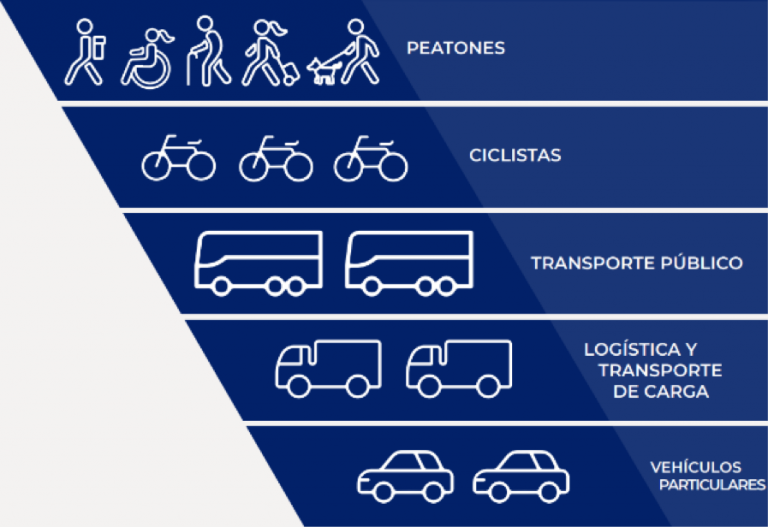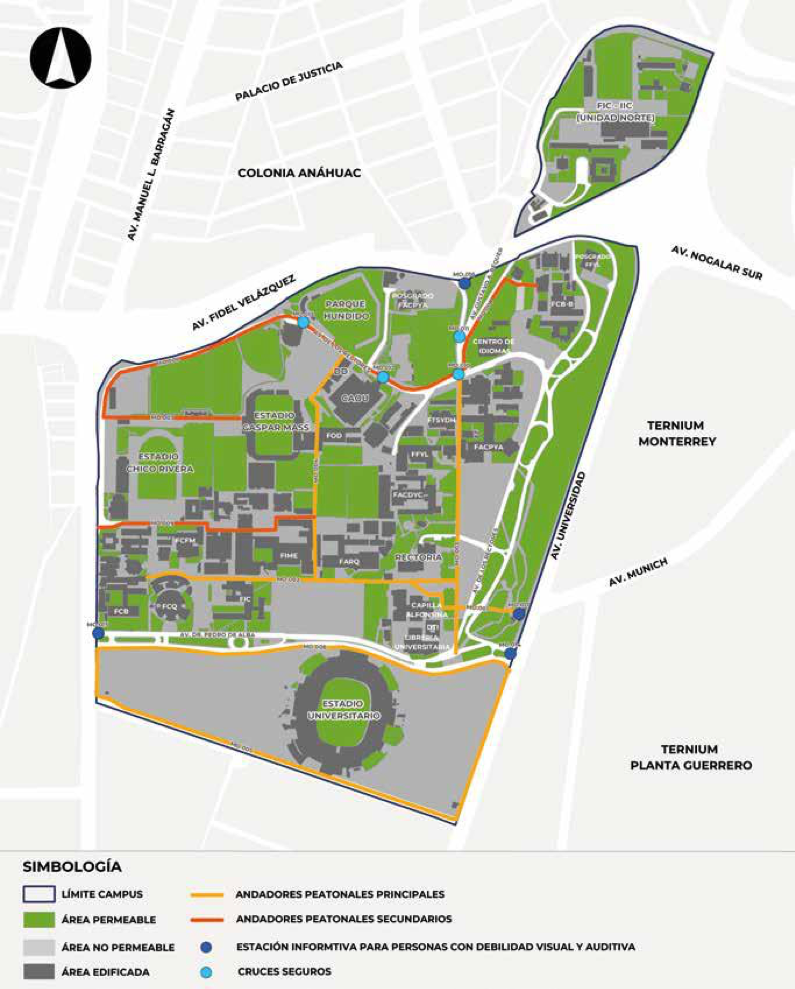Conectividad
Human Scale Mobility Program (University City)
Regarding accessibility, the urban and landscape space must determine its operation. In accordance with the UN-HABITAT Agenda 2016, as well as the federal, state and metropolitan authorities, and finally the UANL Institutional Development Plan 2019-2030, cities must provide the necessary conditions for their communities to be beneficiaries of new forms of social inclusion, including greater equality, access to services and new opportunities, participation and mobilization that reflects the diversity of cities, countries and the world itself.
The university has also continued to promote the use of public university transport as a preferred option for students. It has optimized TigreBus routes to ensure greater frequency and coverage. In addition, the UANL has launched awareness campaigns to encourage the use of shared transport, promoting the reduction of the number of vehicles in circulation and, therefore, greenhouse gas emissions.
When it comes to accessibility, the design of urban and landscape space must guide its operation. According to the UANL Institutional Development Plan 2019-2030, cities must create the necessary conditions for their communities to enjoy new forms of social inclusion. This includes greater equality, access to services and new opportunities, as well as participation and mobilization that reflect the diversity of cities, countries and the world as a whole.
On the campus of Ciudad Universitaria (CU) a high percentage of the population moves to and from campus, so it is of utmost importance that non-motorized mobility is prioritized on this campus. Betting on this mobility model has multiple benefits, both for the environment and for the user, since it reinforces the social fabric, also contributing to the creation of public space infrastructure, thus promoting, through urban design, cities more inclusive and sustainable.
Specific objectives
- Connect the interior of the campus with the immediate context of CU, prioritizing safe pedestrian mobility.
- Encourage the use of non-motorized transportation on campus to improve mobility.
- Discourage car use by reorganizing parking spaces.
Generate collaboration agreements to efficiently link with key actors, including: Municipalities and State Agencies.
Policies
- Programs and projects that favor the use of non-motorized means of mobility and the safety and integrity of pedestrians will be prioritized.
- Non-motorized mobility will be encouraged within CU.
- Connections will be implemented between agencies, as well as alternatives to promote the use and movement of non-motorized mobility.
- The efficiency and safety of internal collective transportation systems will be promoted.
- Projects will be promoted for the reorganization and improvement of vehicular circulation routes.
- Accessibility will be promoted between campus spaces and buildings, as well as with the immediate external context.
Ordering
- Planning and implementation of a support system for non-motorized mobility around the campus.
- Coordinate actions between departments and faculties related to the planning, elimination and improvement of physical barriers that prevent free movement between spaces and buildings.
- Coordinate with external urban transportation the planning, time programming and security of their routes that pass through CU.
- Develop urban improvement actions at the entrances to the CU campus, to regulate the entry and exit of motorized means of mobility.
Planning
- Promote the improvement of roads, walkways and pedestrian crossings to facilitate non-motorized movement in CU.
- Promote non-motorized and zero-carbon mobility.
- Promote the reorganization of spaces intended to serve motorized vehicles.
- Manage the removal of obstacles, elements and/or barriers that put non-motorized mobility at risk in a safe manner, as well as universal accessibility.
Goals
- Connect 70% of the interior areas of the campus through walkways and pedestrian crossings during the period 2021 – 2024.
- Encourage 50% of private car users to use non-motorized means of transportation during the period 2021-2024.
- Reorganize 40% of parking spaces during the period 2021 – 2024.
- Generate an updated collaboration agreement with the municipality of San Nicolás de los Garza during the period 2021 – 2024.
Projects
During 2023, field studies, architectural design and development of technical specifications were carried out for the projects that will begin their construction and development stage during 2024:
1.- Connect
Mobility project for the connection and closure of the pedestrian walkway and cycle path circuit on the Ciudad Universitaria campus, contemplating the construction of a pocket park and a pick-up and drop-off bay for public transport.
Area: 3,128.20 m²
Beneficiaries: 80,000 people
Components:
a) One-way cycle path
b) Trees: 35 individuals
c) Bollards: 30 pieces
d) Urban lighting: 10 pieces
2. Connect Stage 3. South body stage 1
Rehabilitation of the southern section of Av. Pedro de Alba, which includes the reconstruction of the pedestrian sidewalk with universal accessibility components, in order to ensure universal accessibility and safe and comfortable spaces.
Area: 1,201.17 m²
Beneficiaries: 80,000 people
Components:
a) TigreBus structure
b) Bolados: 26 pieces
c) Waste modules: 15 pieces
d) Water drinkers: 2 pieces
e) Street lights: 11 pieces
f) Pedestrian lights: 6 pieces
3. Connect Stage 3. South body stage 2.
Rehabilitation of the southern section of Av. Pedro de Alba, which includes the reconstruction of the pedestrian sidewalk with universal accessibility components, in order to ensure universal accessibility and safe and comfortable spaces.
Area: 1,201.17 m²
Beneficiaries: 80,000 people
Components:
a) Bollards: 16 pieces
b) Garbage Modules: 5 pieces
c) Street lights: 4 pieces
d) Pedestrian Lighting: 6 pieces
4. Connect. North Gas.
The plan is to move the bridge and add an elevator, a landing area and stairs. Add trees, street furniture and floor finishes.
Height: 5.20 meters
Development: 91 ML
Slope: 6%
5. Green corridor. Faculty of Communication Sciences, Green Corridor Av. Aqueduct
Comprehensive mobility project from the access area of the Faculty of Communication Sciences to Av. Acueducto with the intervention of a green corridor. Complying with the premises of reorganization of public space, parking, walkways and accesses, in addition to urban mobility elements and equipment.
Area: 1,174.00 m²
Beneficiaries: 80,000 people
Components:
a) Cycle path: 3,438.00 m²
b) Sidewalk: 5,089.00 m²
c) Trees: 287 pieces
d) Safe crossings – speed bumps: 7
e) Ascent and descent bay: 4
f) Waiting area: 2
g) Viewpoints – rest area: 5
6. Corredor Verde. Distrito Médico Gonzalitos.
Comprehensive mobility project prioritizing non-motorized transport, urban design of widening sidewalks, reorganization of vehicle flow, street-level commerce and collector parking. Universal accessibility infrastructure, improvement of bus stations with big data for circuit control and recovery of public space.
Area: 1,174.00 m²
Beneficiaries: more than 22,575 people
Components:
a) Cycle path
b) Stool
c) Safe crossings
d) Trees
e) Speed zone 30 km/h
f) Street furniture
g) Luminaires



